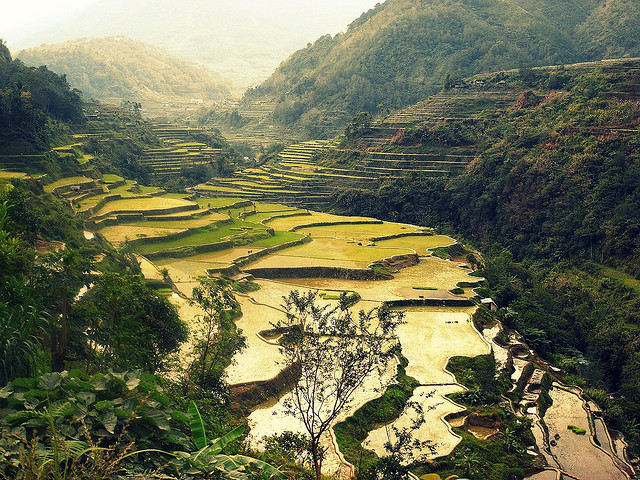No. 16 (2013): Un/Natural Histories

Although European thought has traditionally placed “nature” in opposition to “culture,” recent work in eco-criticism has emphasised the importance of the relationship between our environment and the literary and scholarly work we produce. Similarly, in popular culture, programmes such as the BBC’s Unnatural Histories (2011) investigate the ways in which even the most pristine “natural” spaces can be seen as human constructions. These approaches not only emphasise the relationship between nature and culture as an object of investigation, but also indicate that the way in which this relationship is perceived may not be as “natural” as we assume. A historicising exploration of the natural is taken up and expanded on by the articles gathered in this issue of Forum, which includes work from scholars based in disciplines as diverse as anthropology, science and technology studies, literature and film studies.

Fields of Gold', Rice Fields in Banaue in the Philippines, by kudumomo 19/02/2010 (link to original).
The degree to which our relationship to the natural colours not only our representations of the environment in art and literature but also our self-representations and attitudes as scholars provides the starting point for the first of our guest contributions from anthropologist Mattijs van de Port. Charting the relationship between his father’s fetishisation of “natural” materials and modes of behaviour and his own punk embrace of the explicitly artificial, Van de Port interrogates his personal experiences of the natural in everyday materials and practices before linking these with a discussion of his research into camp and baroque as denaturalising aesthetics which nevertheless provoke bodily reactions. Van de Port’s anthropological perspective on his position as researcher provides a candid insight into the links between the personal environment and research, which we hope will be of particular relevance to a postgraduate readership.
The desire to provoke new reactions and ways of reading is also at the heart of the article of our second guest contributor, Christopher Leslie. Leslie re-reads Shakespeare’s The Tempest to undertake an examination both of the roots of Natural History and of related contemporary discourses on the categorisation of humans. Not only does this function to historicise and so denaturalise a teleological view of developments in scientific enquiry and thought, for Leslie it also has important pedagogic value. He suggests that The Tempest “represents a unique opportunity to understand that the pre-Enlightenment vision of deductive thinking based on Aristotle did not necessarily promote racial hierarchy,” an insight, as he argues, which allows one to focus on the processes behind racialisation, the social construction of race (10, 2).
This engaged approach to scholarship is continued in Emma Trott and Justine Seran’s analyses of postcolonial writing through an eco-critical lens. In Seran’s reading of Keri Hulme’s short stories, literary techniques associated with realism, the Gothic, magical realism and the fantastic combine with disturbing personifications of nature to create a “composite literature of unease” centred on the protagonists’ “mutually deleterious relationship with nature” (9). For Trott, on the other hand, Derek Walcott’s use of language and, in particular, metaphor “articulates the tight bonds between various material and ideological processes that are significant to the poet’s commitment to social and environmental justice,” and creates a future-orientated view of the Caribbean “that is free, not from the brutal fact of the colonial past, but from enduring neo-colonial projects that mark Caribbean islands as dehistoricised Edenic spaces that are fair game for the European coloniser” (11, 5). Laura Beattie’s article on Sean Penn’s film version of Into the Wild then takes us into an exploration of recent filmic constructions of the American wilderness, unpacking the ways in which the creation of dehistoricised spaces within the national imaginary is both continued and critiqued by the films structure and visual imagery.
Returning to the sciences and their role in the construction of the natural, April Durham’s article takes us from twentieth century realities to imagined futures. Exploring Ridley-Scott’s sci-fi classic Blade Runner together with the French novel Babylon Babies, Durham aims to move beyond a focus on the “fear that technology and its intelligent actants [...] will profoundly undermine the subjectivity so carefully ascribed to biological humans” and instead open up an exploration of “what is at stake, besides masterful triumph over technology, when considering human intelligence as technically mediated” (1) This re-positioning of the human subject is also fundamental to Genevieve Sartor’s reading of Virginia Woolf’s Between the Acts through co-evolution and complexity theory. Sartor’s detailed analysis reveals a transformative impulse at the heart of the text where the “environment and the subjects within it are engaged in a form of reciprocity that eradicates a deterministic partitioning of species organisation” (1).
Finally, moving from Woolf to wolves, Håkon Stokland’s article on the construction of a population of wolves in Scandinavia as “natural” and so to be protected illustrates how crossing disciplinary boundaries between the humanities and the sciences can “change the subject” in more ways than one. Stokland convincingly argues: “[a]s the processes of constructing nature often have great impact on the politics concerning both nature and humans, they should be obvious targets for critical examination by scholars from the social sciences and the humanities” (1). While Leslie undoes the history of the discipline via Shakespeare, Stokland thus unravels the ways in which natural history is created and shapes environmental policy today.
Editors: Laura Chapot & Lizzie Stewart
Editorial Review Panel: Victoria Anker, Enti Arends, Dorothy Butchard, Muireann Crowley*, Marta Dąbrówka*, Kate Dunn, Mackenzie Doss, Yanbing Er*, Sarah Faulkner, Alison Garden*, Michael Hannan, Li-hsin Hsu, James Leveque, Lucy MacRae, Lila Matsumoto, Sophia Morris, Justine Seran, Dawn Sherratt-Bado*, Leah Stolzenburg, Mikey Woods*. Article Editors are marked with a star(*)





